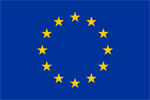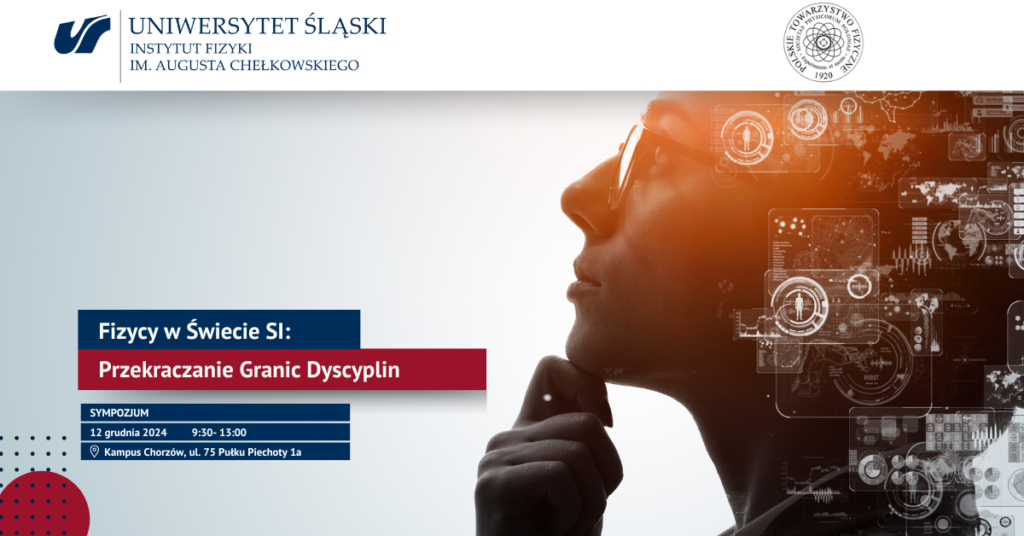Dyrekcja Instytutu Fizyki UŚ oraz Polskie Towarzystwo Fizyczne mają zaszczyt i przyjemność zaprosić na wyjątkowe sympozjum naukowe „Fizycy w Świecie SI: Przekraczanie Granic Dyscyplin”, która odbędzie się w dniu 12 grudnia 2024 roku w Kampusie Chorzowskim Uniwersytetu Śląskiego, ul. 75 Pułku Piechoty 1, 41-500 Chorzów w auli P/0/05.
Konferencja ta jest dedykowana najnowszym osiągnięciom z zakresu fizyki oraz sztucznej inteligencji, a jej celem jest zainspirowanie i zintegrowanie środowisk naukowych oraz technologicznych. Wydarzenie będzie doskonałą okazją do zaprezentowania, jak umiejętności i wiedza fizyków przyczyniają się do dynamicznego rozwoju sztucznej inteligencji w różnych dziedzinach, w tym w medycynie i optymalizacji procesów przemysłowych.
Szczególną atrakcją tegorocznego wydarzenia będzie segment poświęcony laureatom Nagrody Nobla w dziedzinie fizyki z 2024 roku, którzy zostali wyróżnieni za przełomowe badania w obszarze komputerów kwantowych oraz ich zastosowań w sztucznej inteligencji. Ich rewolucyjne prace otworzyły nowe horyzonty zarówno w fizyce teoretycznej, jak i stosowanej, stwarzając niespotykane dotąd możliwości rozwoju technologii SI. Ich osiągnięcia będą omawiane podczas konferencji, ukazując, jak te innowacje zmieniają różnorodne branże.
Prelegentami będą fizycy pracujący zarówno na znakomitych uniwersytetach polskich i zagranicznych, jak i w sektorze prywatnym. Przewidujemy wykłady w języku polskim i angielskim.
Aby uczestniczyć w wydarzeniu w formie stacjonarnej, należy się zarejestrować.
Wydarzenie będzie emitowane na kanale Youtube: kliknij tutaj
9:30 – 10:15 dr Stuart Gibson, Physics-Driven AI and AI-Driven Physics, Exploring a Symbiotic Evolution, wykład w języku angielskim
This lecture examines the intersection of physics and artificial intelligence (AI), inspired by the pioneering contributions of 2024 Nobel Laureates John Hopfield and Geoffrey Hinton. We begin with an accessible introduction to machine learning and AI fundamentals, setting the stage for understanding the Nobel-winning advancements in neural networks and associative memory. By drawing on principles from physics, Hopfield and Hinton created adaptive models that enable autonomous pattern recognition, influencing developments from image recognition to the transformative potential of deep learning.
The presentation will showcase AI’s impact within physics, highlighting applications in materials science, particle research, and other fields. The speaker will also share insights from his own work in chemometrics and AI’s role in the natural sciences. Concluding with a forward-looking perspective, we will explore how collaborative AI-physics efforts may shape the future of scientific discovery and lead to new breakthroughs.
10:25 – 10:55 dr Anna Dawid, Wyjaśniać czy interpretować? Czyli jak uczyć się (fizyki kwantowej) od sieci neuronowych
Głębokie uczenie maszynowe rewolucjonizuje przemysł i obiecuje zmienić oblicze nauki. Ma jednak liczne ograniczenia, z których najistotniejszym z punktu widzenia rozwoju nauki jest to, że sieci neuronowe są „czarnymi skrzynkami”. Taka konstrukcja uniemożliwia nam zrozumienie jak dochodzą do podawanych wniosków czy odpowiedzi, co sprawia, że nie możemy się od nich uczyć. W tej prezentacji omówię różne ograniczenia sieci neuronowych, a także sposoby, by „otworzyć” te czarne skrzynki za pomocą metod wyjaśniania modeli uczenia maszynowego. Pokażę też na przykładzie prostego problemu z fizyki jak można budować sieci o interpretowalnej konstrukcji, przez zmuszanie ich do posługiwania się „językiem”, który rozumiemy.
11:05 – 11:35 dr Ciro Taranto, Visualize, Predict, Plan: Synergies between Physics and Artificial Intelligence applied to Hydropower, wykład w języku angielskim
In this presentation, I will highlight how the skillset built as a researcher in theoretical physics has helped me to shape my motto in artificial intelligence: “Visualize, Predict, Plan”.
Visualizing very abstract quantities is fundamental to interpret the results of complex simulations in condensed matter physics, but is also a key part of exploratory data analysis in machine learning. Predicting, one of the “standard” tasks of machine learning, can benefit from the art of approximating mathematical models in theoretical physics: which relations can be assumed to be linear? Which quantities can we neglect? Finally, in order to plan actions in the real world one needs to be able to translate real-life problems into mathematical models: this is a fundamental step which allows to fully exploit the computational power that modern artificial intelligence frameworks offer us.
11:45 – 12:15 dr Emil Kaptur, Użycie metod uczenia maszynowego w optymalizacji efektywności paliwowej linii lotniczych na podstawie danych z rejestratorów szybkiego dostępu (tzw. czarnych skrzynek)
StorkJet zajmuje się tworzeniem oprogramowania wspierającego linie lotnicze w zwiększeniu efektywności paliwowej oraz zmniejszeniu emisji CO2 oraz pozostałych czynników wpływających na klimat. Operacje lotnicze są skomplikowane. Na szczęście, można je rozważać jako sumę prostszych składowych, w których decyzje dyspozytora, pilota, autopilota, itd. wpływają w różny sposób na spalanie paliwa i osiągi samolotu. StorkJet stworzył modele uczenia maszynowego, które opisują prawie każdy aspekt operacji lotniczych. Użycie tych modeli w produktach StorkJet pozwala linii lotniczej na określenie optymalnej procedury wykonania operacji oraz oszczędności związanych ze zmianą procedur. Podczas prezentacji StorkJet przedstawi:
- Stworzenie prostego modelu uczenia maszynowego. Od odczytu „czarnych skrzynek”, do (niezbyt dokładnego) wyznaczenia trybu ciągu użytego podczas wznoszenia samolotu.
- Symulacja wznoszenia samolotu. Jak zmieni się zużycie paliwa jeśli pilot użyłby innej prędkości wznoszenia.
- Symulacja kołowania na jednym silniku używająca modeli uczenia maszynowego do przewidywania zachowania pilota.
12:25 – 12:55 dr hab. Marcin Kostur, prof. UŚ, Zobaczyć niewidzialne z pomocą głębokiego uczenia: o rekonstrukcji zastawki aortalnej w tomografii komputerowej bez kontrastu.
Dokładna segmentacja zastawki aortalnej (AV) w tomografii komputerowej (CT) bez kontrastu jest kluczowa dla oceny nasilenia chorób AV oraz identyfikacji pacjentów, którzy mogą skorzystać z interwencyjnych zabiegów chirurgicznych. Jednakże, niska widoczność AV w tego rodzaju obrazach medycznych stanowi poważne wyzwanie. W niniejszym wykładzie przedstawimy innowacyjną metodę semi-automatycznego generowania danych referencyjnych (Ground Truth) opartą na rejestracji obrazów, która umożliwia trenowanie modeli sieci neuronowych w procesie słabego nadzoru, zdolnych do precyzyjnej segmentacji AV jedynie na podstawie obrazów CT bez kontrastu. Ponadto, zaprezentujemy nowatorskie podejście do oceny dokładności segmentacji, polegające na rejestracji sztywnych masek segmentowanych w obrazach kontrastowych i bez kontrastu dla każdego pacjenta. Wyniki przeprowadzone na otwartym zbiorze danych wykazują, że nasz model potrafi zidentyfikować AV z średnim błędem mniejszym niż 1 mm, co wskazuje na znaczny potencjał zastosowań klinicznych.
dr Stuart Gibson został mianowany na stanowisko wykładowcy w Szkole Fizyki i Astronomii na Uniwersytecie w Kent w 2007 roku. Jest współtwórcą systemu kompozytowego twarzy EFIT-V, który jest obecnie używany przez większość brytyjskich jednostek policji i w wielu innych krajach. Głównym tematem badań dr Stuarta Gibsona są zastosowania przetwarzania obrazu cyfrowego i uczenia maszynowego w kryminalistyce.
dr Anna Dawid jest jest naukowczynią zajmującą się fizyką kwantową i uczeniem maszynowym w Leiden University, a także entuzjastką teatru i gier. Chętnie bawi się interpretowalnym uczeniem maszynowym w nauce, ultrazimnymi platformami do symulacji kwantowych i teorią uczenia maszynowego. Jest pasjonatką kształtowania zautomatyzowanych podejść w unikalną nową soczewkę naukową i patrzenia przez nią na ustalone trudne problemy kwantowe.
dr Ciro Taranto jest liderem ds. optymalizacji i uczenia maszynowego w HYDROGRID, znanym ze swojej pasji do liczb i tłumaczenia rzeczywistych problemów na modele matematyczne i kod. Dzięki doświadczeniu w uczeniu maszynowym i sztucznej inteligencji wnosi analityczną precyzję i pragmatyczne podejście do rozwiązań. Ciro jest fizykiem, oddanym programistą Pythona, komunikatorem naukowym i członkiem zespołu, którego napędza ciekawość i determinacja.
dr Emil Kaptur jest szefem działu badań i rozwoju w StorkJet. Posiada tytuł doktora fizyki eksperymentalnej, a jego wiedza specjalistyczna w zakresie analizy danych i uczenia maszynowego pochodzi z jego poprzedniej pracy w Europejskiej Organizacji Badań Jądrowych (CERN). Obecnie kieruje zespołem badaczy uczenia maszynowego o zróżnicowanym doświadczeniu, rozszerzającym modele wydajności StorkJet, aby obejmowały nie tylko wydajność w locie, ale wszystkie obszary operacji lotniczych, w których można oszczędzać paliwo.
dr hab. Marcin Kostur, prof. UŚ to wykładowca akademicki i naukowiec, którego badania obejmują szeroki zakres tematów. Jego najnowsze prace naukowe skupiają się na zagadnieniach zastosowań fizyki w medycynie i analizie obrazów medycznych.W swoich ostatnich publikacjach, badał między innymi transport lipoprotein niskiej gęstości w ścianach tętnic oraz wykorzystanie głębokiego uczenia w interpretacji i modelowaniu procesów istotnych w diagnostyce chorób serca. Jest autorem rozwiązań technologicznych wykorzystujących uczenie maszynowe w analizie obrazów tomografii komputerowej.
I am text block. Click edit button to change this text. Lorem ipsum dolor sit amet, consectetur adipiscing elit. Ut elit tellus, luctus nec ullamcorper mattis, pulvinar dapibus leo.






